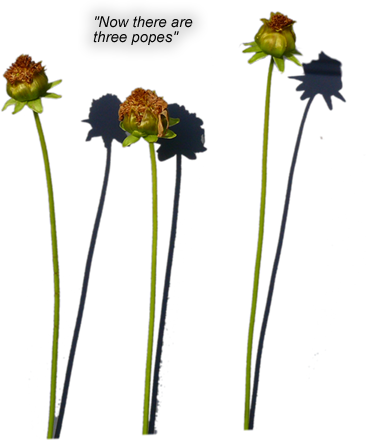Issue # 7 – Christianity vs Religion
THREE POPES AT A TIME
The Conclave became the established method of electing popes. The Conclave is the gathering of cardinals, upon the death of a pope, to elect a new pope whereby the popes are assembled in one room and not allowed out until a pope had been elected by two-thirds majority. The Conclave was started, not by the clergy, but the laity. The stability of Europe, in those years, depended upon a pope being seated on the papal throne. But often after a pope died the rivalrous cardinals who represented various families and countries could not come to a decision and the papal seat remained vacant, as long as two and a half years at a time. So the cardinals were not allowed to come out of their meeting place until they came to a conclusion. Often armed guards were posted to keep them from escaping.
Different methods were employed to hurry the cardinals – limit them to bread and wine or just water, remove the roof thus exposing them to the weather, lock the doors, refuse them wages or other money, threaten to burn the place with them in it, etc., etc. Still they often took a long time coming to a decision, so fearful were they of offending a powerful ally.
In 1378 the French pope, Pope Gregory XI died and the Italian populace, tired of French popes, clamor for an Italian replacement. Unfortunately the French cardinals outnumber the Italian cardinals and there is no way an Italian replacement will be voted in. The Romans bring in 6,000 foot soldiers to prevent the cardinals’ escape, forcing the Conclave to take place in the Vatican where the Italians can apply pressure. “A Roman or an Italian!” the crowd chants menacingly to the cardinals inside. The cardinals, however, do elect a French pope, Pope Urban VI (a harsh and shady man), and quiver in fear of the mob outside. They trick the people by presenting to them an old man, an Italian, dressed in the pope’s attire, and while the Italians are kissing the old man’s hands and feet the cardinals run for their lives.
After this fiasco, sixteen cardinals hold their own conclave and install Pope Clement VII who returns to France. Now there are two popes. Both popes die and each has their successors. Eventually another pope (Pope Alexander, to be succeeded by Pope John XXIII) is elected to replace these successors. Now there are three popes. Each excommunicates the other two. All of Europe is hurting. After a series of bribes, arrests, assassinations, poisonings, intrigue, scuffles, threats, debates, excommunications, betrayals, cheatings, perjuring and imprisonments by the popes and their respective cardinals and allies, the mess finally gets staightened out about ten years later upon the election of Pope Martin V (who immediately squashes all efforts of much needed church reform).


